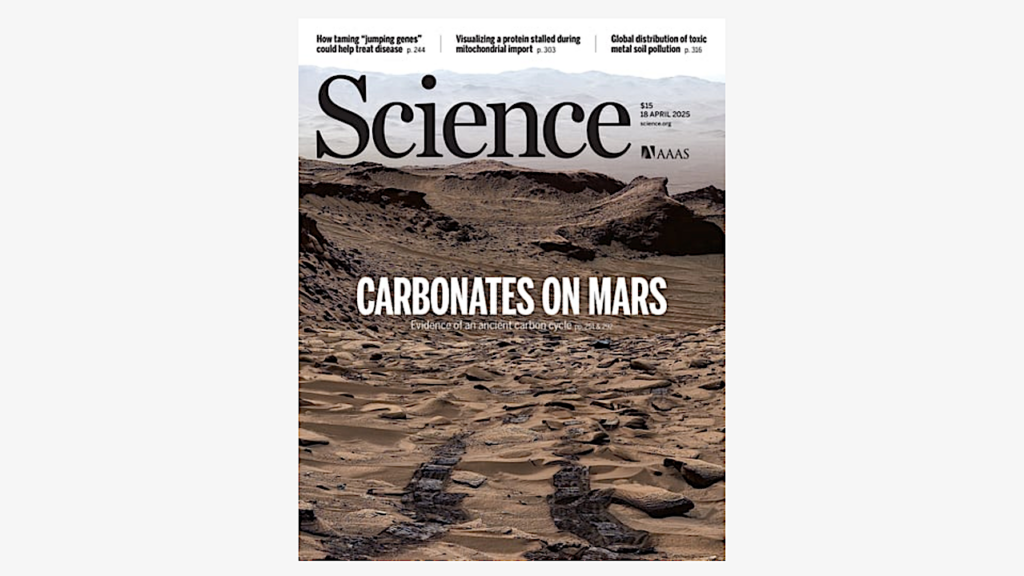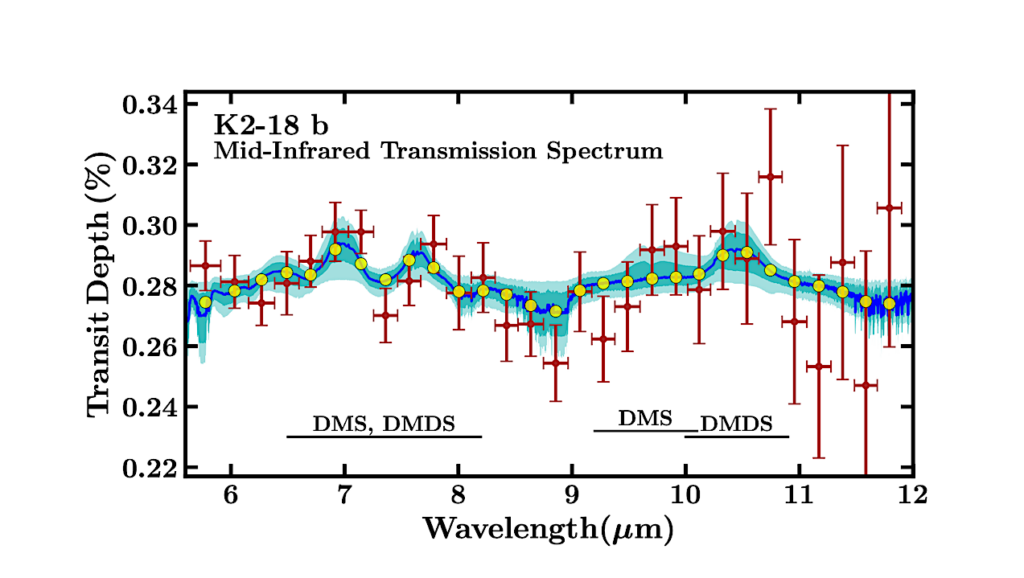NASA's Big Arsenic-Based Life Claim Was Wrong
 Absence of Detectable Arsenate in DNA from Arsenate-Grown GFAJ-1 Cells, Science
Absence of Detectable Arsenate in DNA from Arsenate-Grown GFAJ-1 Cells, Science
GFAJ-1 Is an Arsenate-Resistant, Phosphate-Dependent Organism, Science
Discovery of an arsenic-friendly microbe refuted, USA Today
“The discovery of an arsenic-loving microbe that NASA said would rewrite biology textbooks and offered hope of life on other planets now looks like a case study in how science corrects its mistakes, researchers report. In findings released Sunday by the journal Science, two research teams take aim at the “arseniclife” bacteria. The microbe was announced by the journal in 2010 at a NASA news briefing as “the first known microorganism on Earth able to thrive and reproduce using the toxic chemical arsenic.” The new findings show that was not the case.”
 Keith’s 8 Jul note: Now that Science magazine has published two papers that refute NASA’s big announcement several years ago, I wonder if NASA SMD PAO will reference these papers and admit that the claims made in earlier NASA statements were indeed wrong. I’m not holding my breath. It will also be interesting to see how Science magazine handles this issue since these two new papers in Science refute the original paper – which was also published in Science.
Keith’s 8 Jul note: Now that Science magazine has published two papers that refute NASA’s big announcement several years ago, I wonder if NASA SMD PAO will reference these papers and admit that the claims made in earlier NASA statements were indeed wrong. I’m not holding my breath. It will also be interesting to see how Science magazine handles this issue since these two new papers in Science refute the original paper – which was also published in Science.
 Keith’s 9 Jul update: Still no response from NASA despite several requests. All they’ve said is that they are working on a response.
Keith’s 9 Jul update: Still no response from NASA despite several requests. All they’ve said is that they are working on a response.
 Keith’s 9 Jul further update: After ignoring the first request from NASAWatch made first thing this morning, a second request this evening elicited this response – one that was sent earlier today to other media outlets from Michael H. New, astrobiology discipline scientist in NASA’s Planetary Science Division at NASA Headquarters:
Keith’s 9 Jul further update: After ignoring the first request from NASAWatch made first thing this morning, a second request this evening elicited this response – one that was sent earlier today to other media outlets from Michael H. New, astrobiology discipline scientist in NASA’s Planetary Science Division at NASA Headquarters:
“NASA supports robust and continuous peer review of any scientific finding, especially discoveries with wide-ranging implications. It was expected that the 2010 Wolfe-Simon et al. Science paper would not be exempt from such standard scientific practices, and in fact, was anticipated to generate significant scientific attention given the surprising results in that paper. The two new papers published in Science on the micro-organism GFAJ-1 exemplify this process and provide important new insights. Though these new papers challenge some of the conclusions of the original paper, neither paper invalidates the 2010 observations of a remarkable micro-organism that can survive in a highly phosphate-poor and arsenic-rich environment toxic to many other micro-organisms. What has emerged from these three papers is an as yet incomplete picture of GFAJ-1 that clearly calls for additional research.”
Funny how Dr. New won’t address this earlier official NASA SMD PAO hype – often bordering on outlandish – that accompanied the original paper’s publication. No doubt whatsoever with the findings was voiced – nor was there any hint that this paper was an “incomplete picture”:
“Researchers conducting tests in the harsh environment of Mono Lake in California have discovered the first known microorganism on Earth able to thrive and reproduce using the toxic chemical arsenic. The microorganism substitutes arsenic for phosphorus in its cell components. “The definition of life has just expanded,” said Ed Weiler, NASA’s associate administrator for the Science Mission Directorate at the agency’s Headquarters in Washington. “As we pursue our efforts to seek signs of life in the solar system, we have to think more broadly, more diversely and consider life as we do not know it.” This finding of an alternative biochemistry makeup will alter biology textbooks and expand the scope of the search for life beyond Earth.”
Journal retreats from controversial arsenic paper, Washington Post
“Wolfe-Simon, now on a NASA fellowship at the Lawrence Berkeley National Laboratory, is collaborating with senior scientist John A. Tainer on wide-ranging studies of the bacterium … Tainer said the two new studies in Science may have come to different results than theirs because of the methodologies used, the precision used to detect arsenates and the provenance of the cells. He said the authors of the two new papers “may well regret some of their statements” in the future.”
– A Bacterium That Can Grow by Using Arsenic Instead of Phosphorus, Science (original article)
– Doubt Grows About NASA’s Arsenic-based Life Claims, earlier post
– NASA Researchers Start To Backtrack on Earlier Claims, earlier post
– Arsenic, Astrobiology, NASA, and the Media, earlier post
– Snarky NASA SMD Response to Snarky Public Astrobiology Discussion, earlier post
– NASA’s Astrobiology News: Arsenic Biochemistry Anyone? (Update), earlier post









Folks:
I remember that press conference. The lead scientist seemed a little too enthusiastic about her ‘discovery’. The gleam in her eye told me she had fallen for what I’ve seen so many times before in academia and science… she found just exactly what she wanted to find.
Let’s take a deep breath here. This is the way science is supposed to work. And as to that ‘gleam’– we are watching an enthusiastic young researcher at work– and stumble– let’s give her a bit of slack.
No schadenfreude, please, as we watch a young scientist learn a very tough lesson.
This is more than schadenfreude – all of NASA got caught up in this. did not ask the right questions, and got carried away with the notion without doing due diligence.
Agreed, but I’d rather see an excitement-then-correction scenario like this than see no mention/reaction in the media at all from NASA on a possible important discovery, which happens far too often. It would be nice if they were half-way consistent.
We get endless NASA news releases about companies getting facilities service contracts and school kids talking to astronauts, which are of interest only to people who already know about them anyhow, but we get nothing on so many other issues that would be of interest to people outside of NASA who don’t already know about them.
What makes this even more baffling to me is looking at the number of names attached to NASA news releases (sometimes 2 or 3 to a story). Assuming all of those different names belong to people who are supposed to be doing news releases, just what are they doing with the rest of their time? If you multiply the number of “reporters” names we see by the number of working hours in a day, you get an enormous pile of man-hours apparently producing very little output between them.
Is this a candidate for reducing costs, since they can’t seem to do a better job for what they’re paid?
Steve
… without doing due diligence.
… like … checking for sample contamination? Or by rerunning panel screens to confirm that the source of the arsenic was from the sequence itself …
The team that did this soon split up afterwards. Telling.
“It will also be interesting to see how Science magazine handles this issue since these two new papers in Science refute the original paper – which was also published in Science.”Well, I assume that they will “handle” the issue by stating that this is the way the science is done: one scientist (or team) makes an observation, and then others try to replicate it or refute it.
Yes, scientists make errors. Wrong hypotheses and dead ends and repeating and correcting results is part of the process. That’s the way science works.
The error in this case was in the hype, not in the science. Partly that was media frenzy: when NASA had announced a press conference related to astrobiology, half a dozen publications jumped in and said OMG, that must mean NASA is announcing SETI results, they found little green men (not NASAwatch, which stuck to the facts and didn’t join in on the speculation). But only partly. The NASA PAO jumped a little too quickly to a press conference for work that wasn’t ready yet; it really should have had confirmation before starting the hype machine.
Let’s not jump to even more conclusions prematurely. Keith has no idea whether NASA’s claim is right or wrong– only that scientists are disagreeing on the subject. The ball is back in the Wolfe-Simon team’s court to reproduce their results or not.
The science is working here as it should– only PR departments, journalists, and the internet in general are making this appear to be anything other than business as usual.
I guess all those degrees in Biology I have are not useful here.
The degrees are useful for understanding the work/papers and for commentary, but in terms of refuting the initial work of Wolfe-Simon and her team and in terms of science self-correcting according to the scientific method, the degrees are only useful if you do work that refutes or supports Wolfe-Simon’s claims. Science doesn’t self-correct from authority but from demonstration. Science worked in this case just as it should have. As Geoffrey Landis suggested, the problem here was the unleashing of the hype and premature publicity.
-Robin
Mr. Wren stated “Keith has no idea whether NASA’s claim is right or wrong”. Well, I do. I have the background sufficient to read these papers and understand what is in them. That is what NASA used to pay me to do when I ran peer review panels for life science and exobiology research. But there is more to this than dueling claims by scientists: NASA allowed ill-considered hype to be interjected into what should have been a fact-driven discussion.
Yes, and that’s what was said.
Keith, you’d be surprised how many internal researchers get the NASA seal approval that have numerous errors in their methodology or end claims. This is just tip of the iceberg.
The sad part NASA isn’t the only organization to do this at times. It has a lot to do with the need to continually find funding. Notice the comment of the need for “additional research”. Isn’t that already implied to an extent?
I get that our govt is becoming more and more stingy regarding funds to scientific endeavors, NASA included, but It doesn’t mean everything has to come down to a funding and popularity contest.
The general public while they may pay attention to this drama, but they are not impressed with it.
I doubt you’ll ever see Joe the plumber come out in favor of taxes more science research with this kind of activity. Granted, he probably wouldn’t anyway…but this virtually guarantees it.
I get that our govt is becoming more and more stingy regarding funds to
scientific endeavors, NASA included, but It doesn’t mean everything has
to come down to a funding and popularity contest.
When in the history of the world was it not down to a “funding and popularity contest”?
We’ll continue to fight human nature for countless millenia.
Sounds like good odds that MSL will find some evidence of life that needs further study to me.
I think the real mistake at the time of the video conference and press release was the way it was worded, exterrestrial life found. A bunch of the public watched online and were very disappointed it wasn’t little green men.
Also, regardless of whether it was a phosphate or arsenic based life form, I highly doubt it is exterrestrial (not from earth). It is an earth native that is a little bit different then the norm.